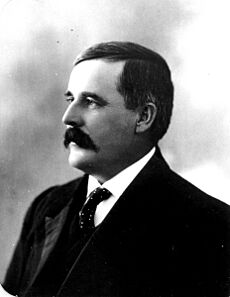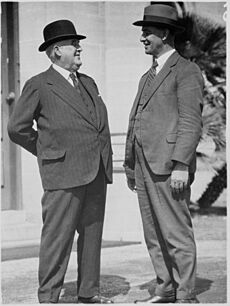James Mitchell (Australian politician) facts for kids
Quick facts for kids
Sir James Mitchell
|
|
|---|---|
 |
|
| 20th Governor of Western Australia | |
| In office 5 October 1948 – 30 June 1951 Acting governor: 11 July 1933 – 5 October 1948 |
|
| Monarch | George VI |
| Premier | Sir Ross McLarty |
| Preceded by | Sir William Campion |
| Succeeded by | Sir Charles Gairdner |
| 13th Premier of Western Australia | |
| In office 17 May 1919 – 16 April 1924 |
|
| Monarch | George V |
| Governor | Sir William Ellison-Macartney Sir Francis Newdegate |
| Preceded by | Sir Hal Colebatch |
| Succeeded by | Philip Collier |
| In office 24 April 1930 – 24 April 1933 |
|
| Monarch | George V |
| Governor | Sir William Campion None |
| Preceded by | Philip Collier |
| Succeeded by | Philip Collier |
| Constituency | Northam |
| Personal details | |
| Born | 27 April 1866 Dardanup, Western Australia, Australia |
| Died | 26 July 1951 (aged 85) Glen Mervyn siding, Mumballup, Western Australia, Australia |
| Political party | Nationalist |
| Spouse | Clara Robinson Spencer (m.1888–1949; her death) |
Sir James Mitchell (27 April 1866 – 26 July 1951) was an important Australian politician. He was the premier of Western Australia twice, first from 1919 to 1924, and then from 1930 to 1933. He led the Nationalist Party. Later, he became the governor of Western Australia, first as an acting governor from 1933 to 1948, and then officially from 1948 until he passed away in 1951.
James Mitchell was born into a farming family in Dardanup, Western Australia. He later became a bank manager in Northam. He was first elected to the Parliament of Western Australia in 1905. He held his seat for almost 30 years. Mitchell quickly became a government minister. He strongly supported farming and agricultural growth. He believed the government should help farmers. He also wanted to bring more people to Australia through assisted migration and help soldiers settle on farms.
Mitchell became Premier for the first time in 1919. His government worked with the Country Party. During his first time as Premier, he brought in small social changes and new projects. He is best known for the Group Settlement Scheme. This plan helped create the dairy industry in the South West region. Mitchell won the 1921 state election but lost in 1924. He became Premier again in 1930, during the Great Depression. However, he lost by a lot in the 1933 election and even lost his own seat. He also allowed a vote on whether Western Australia should leave Australia in 1933.
After losing his job as Premier, Mitchell was made lieutenant-governor. This was because the government wanted to save money during the Great Depression. He served as acting governor until 1948. He then became the official Governor until his death in 1951.
Contents
Early Life and Career
James Mitchell was born on 27 April 1866 in Dardanup, Western Australia. He was the oldest of 13 children. His father was a farm manager.
Mitchell went to school in Bunbury. In 1885, he started working for the Western Australian Bank. He first worked in Geraldton. Then, in 1890, he became the manager of the bank's Northam branch. Both Mitchell and the bank did very well during the Western Australian gold rushes. Northam was an important stop on the way to the goldfields. Mitchell's success allowed him to buy his own farm. He always cared a lot about farming throughout his time in politics. In 1897, he became a justice of the peace, which is a public official.
Starting in Politics
Mitchell was elected to the Western Australian Legislative Assembly (part of the state parliament) in 1905. He won the seat for Northam. In parliament, he strongly supported helping people settle on farms. He thought Western Australia relied too much on food from other places. He wanted to help families get land, especially as the goldfields became less busy and miners looked for new jobs.
In 1906, he became a minister in the government. In 1909, he was promoted to be the Minister for Agriculture and Lands. In 1910, he also became the Minister for Industries.
At the 1911 state election, Mitchell's government lost. As agriculture minister, Mitchell had helped expand farming land. The government supported new farming methods and used superphosphate (a type of fertilizer). This pushed farming areas further east into the Wheatbelt. However, there was very little rain in the early 1910s. This caused many farms to fail. Some people blamed Mitchell for being too optimistic and sending new settlers into the bush without enough support. A new group called the Farmers' and Settlers' Association was formed. This group later became the Country Party. They won eight seats in the 1914 state election.
In 1916, Mitchell's party returned to power with the Country Party. However, the Country Party did not want Mitchell to be the agriculture minister again. He was instead made Minister for Industries, Railways, and Water Supply.
Premier: First Term (1919–1924)

On 17 May 1919, the Premier, Hal Colebatch, resigned. James Mitchell took his place. Mitchell won the 1921 election and remained Premier until 1924. During this time, he became well-known for strongly supporting the soldier settlement scheme. This plan helped soldiers who had returned from war get land to farm in the south-west of Western Australia. This plan cost a lot of money and resources. Because he was so keen on this scheme, the local newspapers called him "Moo-Cow" Mitchell. Still, he is largely credited with starting the dairy industry in Western Australia. He was also good at managing the differences between his Nationalist Party and the Country Party.
Mitchell also worked to develop the North-West region. He appointed a special commissioner to encourage growing cotton and other tropical crops. Mitchell and his main ministers wanted the government to be involved in the economy. They were willing to keep state-owned businesses and control prices. This upset some business people who believed in less government involvement.
During Mitchell's first term, laws were introduced to allow women to run for parliament. Divorce laws were also made more flexible. In 1921, Edith Cowan became the first Australian woman elected to parliament. Mitchell supported her bill in 1922. This bill allowed mothers to inherit an equal share from their children if they died without a will. He also supported her bill to allow women to become lawyers.
Starting in 1919, Perth faced a serious water shortage. This was because the water supply had not grown as fast as the city. Mitchell's government put limits on water use in 1920. In 1923, Mitchell announced a plan to build new dams in the Perth Hills. These included Canning Dam. However, this project was expected to take six years. In the summer of 1923–24, some areas of Perth still had severe water shortages. Water had to be delivered by carts. Mitchell and his government mainly represented country areas. People felt they did not care enough about the city's water problems. This water crisis helped lead to his government's defeat in the 1924 election.
Premier: Second Term (1930–1933)
Mitchell was elected Premier for a second time in the 1930 election. This happened at the start of the Great Depression. His government was defeated in the 1933 elections. He also became the first Western Australian Premier to lose both a state election and his own parliamentary seat (Northam).
In November 1930, Mitchell said he personally supported Western Australia leaving Australia. This idea, called secession, grew stronger during the Great Depression. People felt the federal government was not doing enough to help. Mitchell said he was a "federalist who could not pay the price." In November 1931, his government introduced a bill for a vote on secession. This vote happened at the same time as the 1933 election. Western Australia voted to leave Australia by almost two-thirds. However, this vote was not successful in the end.
Governor of Western Australia
During the Great Depression, many places faced money problems. In July 1933, James Mitchell was appointed Lieutenant-Governor of Western Australia. This meant he lived in Government House, Perth, and acted as governor. However, he did not receive a salary. This saved public money when times were tough. He held this position until he was officially made Governor of Western Australia in 1948.
Mitchell was the first Australian-born Governor of Western Australia. He is still the only person to have been both Premier and Governor of the state. He retired from the job in June 1951.
Family Life
In 1888, Mitchell married Clara Robinson Spencer. She was the daughter of the mayor of Bunbury. They had three sons and one daughter. Sadly, three of his children passed away before him. His wife passed away in 1949.
Death and Legacy
Mitchell passed away on 26 July 1951, at 85 years old. He was in his private railway carriage, stopped at a small train siding called Glen Mervyn. He was on a tour of the southwest of the state. He was given a special state funeral and was buried at Karrakatta Cemetery.
Many things have been named in his honour. These include the Mitchell Freeway, Sir James Mitchell Park in South Perth, and Sir James Mitchell National Park. A botanist named a flower, the rapier featherflower, Verticordia mitchelliana, after him.



